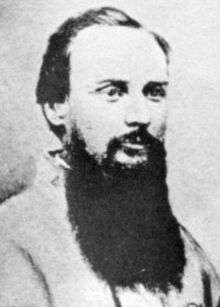Samuel W. Ferguson
| Samuel Wragg Ferguson | |
|---|---|
 Samuel W. Ferguson, Brigadier General in the Confederate Army | |
| Born |
November 3, 1834 Charleston, South Carolina |
| Died |
February 3, 1917 (aged 82) Jackson, Mississippi |
| Place if burial | Greenwood Cemetery |
| Allegiance |
United States of America Confederate States of America |
| Years of service |
1857–61 (USA) 1861–65 (CSA) |
| Rank |
|
| Commands held |
5th South Carolina Cavalry Regiment 28th Mississippi Cavalry Regiment |
| Battles/wars |
Utah War American Civil War |
| Other work |
President of the United States Board of Mississippi River Commissioners |
Samuel Wragg Ferguson (November 3, 1834 – February 3, 1917) was a career United States Army officer, a cavalryman, and a graduate of West Point. He is best known for being a Confederate brigadier general during the American Civil War.
Early life and career
Ferguson went to West Point and graduated in 1857. Before he graduated, he joined General Albert Johnson's Utah War expedition to fight the Mormons. He then went to St. Louis to join his regiment. After the expedition, Ferguson was assigned to Fort Walla Walla in the Washington Territory, where he stayed from 1859 to 1860. This all changed when he received the results of the 1860 presidential election. Hearing of the election of Abraham Lincoln, he immediately resigned and left for Charleston.[1]
Civil war service
In March 1861, Ferguson joined the provisional army of South Carolina, receiving the rank of captain. He was then appointed as an aide-de-camp to General P. G. T. Beauregard. He was one of those who received the formal surrender of Major Robert Anderson at Fort Sumter, raised the first Confederate flag, and posted the first guards at Fort Sumter. After the battle at Fort Sumter, Ferguson was sent to deliver the first Confederate standard flown that was struck by an enemy shot to the Provisional Confederate Congress in Montgomery.[1]
He was still on Beauregard's staff during the Battle of Shiloh, where he was given his first command of a small brigade. During the Battle of Farmington, he was a lieutenant colonel in the 28th Mississippi Cavalry regiment. He also commanded this unit while defending Vicksburg, Mississippi, and helped stop the attacks made by William T. Sherman and Admiral David Dixon Porter.
In 1863, Ferguson was promoted to brigadier general. Subsequently, he was suggested for promotion to major general, but Major General Joseph Wheeler quickly objected.[2] During Sherman's March to the Sea, Ferguson and his cavalrymen harassed the flank of the Union army. When Sherman got close to Savannah, Ferguson's men left their horses and covered the Confederate retreat. He was then ordered to Danville, Virginia, but before arriving was ordered to go to Charlotte, North Carolina. From Charlotte he escorted Jefferson Davis into Georgia, where his unit was disbanded.[3]
Postbellum career
After the war Ferguson moved to Mississippi where he opened up practice in law. He was the husband of Catherine Lee, daughter of Henry William and Eleanor Percy Lee who was a cousin of Robert E. Lee.[3]
In 1876 he was appointed as president of the United States Board of Mississippi River Commissioners. He was also secretary and treasurer of the Mississippi Levee Board. In the early 1890s, Ferguson moved back to his hometown of Charleston, South Carolina, and worked as a civil engineer. At the outbreak of the Spanish–American War, Ferguson tried to join the war effort but he was turned down.[1] On February 3, 1917, he died in Jackson, Mississippi, where he is buried also at the Greenwood Cemetery[2] along with other famous Confederate generals.
Mississippi Levee Board scandal
In 1894, twenty thousand[4] to forty thousand dollars[5] mysteriously disappeared from the Mississippi Levee Board, of which Ferguson was both secretary and treasurer.[4] Later that year, he suddenly left and moved to Charleston. After staying in Charleston, Samuel moved to Ecuador. It would be many years before he returned.[4]
See also
Notes
References
- Black, Patti Carr and Marion Barnwell, Touring Literary Mississippi (2002) pg. 9–10.
- Eicher, John H., and David J. Eicher, Civil War High Commands. Stanford: Stanford University Press, 2001. ISBN 978-0-8047-3641-1.
- Kansas State Historical Society's Collections of the Kansas State Historical Society (1912) pg. 303
- Sifakis, Stewart. Who Was Who in the Civil War. New York: Facts On File, 1988. ISBN 978-0-8160-1055-4.
- Warner, Ezra J. Generals in Gray: Lives of the Confederate Commanders. Baton Rouge: Louisiana State University Press, 1959. ISBN 978-0-8071-0823-9.
- Wyatt-Brown, Betram, The Literary Percys: Family History, Gender & the Southern Imagination ( 1994) pg. 46–47